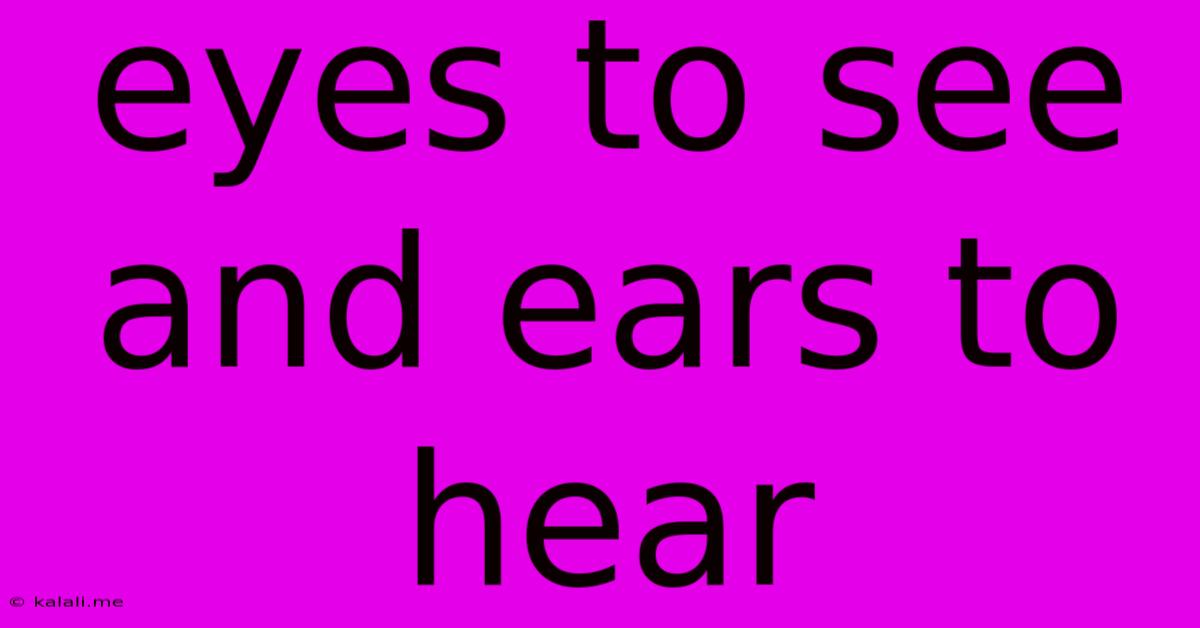Eyes To See And Ears To Hear
Kalali
Jun 05, 2025 · 4 min read

Table of Contents
Eyes to See and Ears to Hear: Cultivating a Deeper Understanding of the World Around Us
Meta Description: Explore the profound impact of sight and hearing on our perception of the world. This article delves into the sensory experiences of seeing and hearing, their interconnectedness, and how we can enhance our appreciation of them.
Our senses are the gateways to experiencing the world. While we often take them for granted, the ability to see and hear profoundly shapes our understanding, emotions, and interactions. This article explores the intricate relationship between our eyes and ears, examining how these senses work together to create a rich and multifaceted perception of reality. We will also discuss how we can cultivate a greater appreciation for these invaluable gifts.
The Power of Sight: More Than Meets the Eye
Sight is arguably our dominant sense, providing a constant stream of visual information that shapes our understanding of space, distance, and form. From the intricate details of a blooming flower to the vast expanse of a starry night, our eyes capture a breathtaking range of visual stimuli. But seeing is more than just perceiving light; it's about interpreting and making sense of that information. Our brains actively process visual data, constructing a cohesive and meaningful representation of the world around us. Consider the complexity involved in simply recognizing a face – a process that relies on the intricate interplay of light, shadow, and pattern recognition.
Visual perception also plays a crucial role in our emotional responses. The vibrant colors of a sunset can evoke feelings of peace and tranquility, while a chaotic scene might trigger anxiety or fear. This emotional connection to visual input underscores the profound impact sight has on our overall well-being. Furthermore, visual impairments significantly affect daily life, highlighting the crucial role of sight in navigating and interacting with our environment. Think about the challenges of reading, driving, or simply crossing a street without clear vision.
The Symphony of Sound: Hearing the World's Music
Hearing, our auditory sense, complements sight by providing a different dimension to our perception of the world. Sound offers clues about the environment that are unavailable to our eyes. The rustle of leaves, the chirping of birds, the distant rumble of thunder – these sounds paint a sonic landscape that adds depth and richness to our experience. Just as our brains actively process visual information, they actively decode auditory signals, translating vibrations into meaningful sounds and understanding their source and significance. The subtle nuances of human speech, the melodic complexity of music, and the percussive energy of a storm all rely on our hearing.
Hearing also plays a vital role in communication and social interaction. From intimate conversations to public announcements, sound forms the foundation of much of our daily communication. The ability to hear is essential for social connection and understanding. Imagine the challenges faced by individuals with hearing impairments – the struggle to participate in conversations, comprehend lectures, or enjoy music. This highlights how integral hearing is to social participation and overall quality of life.
The Interconnectedness of Sight and Hearing
While seemingly separate, sight and hearing are deeply interconnected. Our experiences are rarely purely visual or auditory; instead, they are a complex blend of both. For example, watching a movie involves both the visual spectacle and the auditory soundtrack, each enhancing the other to create a richer and more immersive experience. Similarly, observing a live musical performance combines the visual aspects of the musicians’ movements and instruments with the aural experience of the music itself. This interplay between sight and hearing demonstrates how these senses work together to create a holistic and multi-sensory experience.
Cultivating Appreciation for Our Senses
Given the profound impact of sight and hearing on our lives, it's crucial to cultivate an appreciation for these precious gifts. We can achieve this through mindful engagement with our surroundings – actively observing the visual details of our environment and listening attentively to the sounds around us. Taking the time to appreciate a sunset, listen to a symphony, or simply pay attention to the sounds of nature can enrich our lives immensely. Moreover, protecting our senses from damage through practices like regular eye exams and protecting our hearing from loud noises is essential for maintaining our ability to experience the world fully.
By embracing and nurturing our senses, we can cultivate a deeper and more meaningful understanding of the world around us. The ability to see and hear is not just about perceiving; it's about experiencing, connecting, and appreciating the wonders of our sensory world.
Latest Posts
Latest Posts
-
Imam Ali Create Light From Water
Jun 06, 2025
-
Can A Live In Person Buy Life Insurance On Their Apartment
Jun 06, 2025
-
Another Word For Outside Of Our Hands
Jun 06, 2025
-
How To Play Spotify With The F8 Key On Mac
Jun 06, 2025
-
Does Car Battery Charge While Idling
Jun 06, 2025
Related Post
Thank you for visiting our website which covers about Eyes To See And Ears To Hear . We hope the information provided has been useful to you. Feel free to contact us if you have any questions or need further assistance. See you next time and don't miss to bookmark.